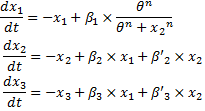Team:Paris/Modeling/BOB/Akaike
From 2008.igem.org
(Difference between revisions)
(→Short presentation of the criteria) |
|||
| Line 4: | Line 4: | ||
<center><html><div style="color:#275D96; font-size:2em;">Model Comparison</div></html></center> | <center><html><div style="color:#275D96; font-size:2em;">Model Comparison</div></html></center> | ||
<br> | <br> | ||
| - | = Short | + | = Short introduction to the criteria = |
* Using linear equations in a biological system might seem awkards. However, we wanted to check the relevance of this approach. We have been looking for a criterium that would penalize a system that had many parameters, but that would also penalize a system which quadratic error would be too important while fitting experimental values. The goal here is to decide whether, assuming that the experimental data looks like a model based on Hill functions, the linear part of the BOB model is obsolete or not. | * Using linear equations in a biological system might seem awkards. However, we wanted to check the relevance of this approach. We have been looking for a criterium that would penalize a system that had many parameters, but that would also penalize a system which quadratic error would be too important while fitting experimental values. The goal here is to decide whether, assuming that the experimental data looks like a model based on Hill functions, the linear part of the BOB model is obsolete or not. | ||
* Akaike and Schwarz criteria taken from the information theory met our demands quite well : | * Akaike and Schwarz criteria taken from the information theory met our demands quite well : | ||
| Line 13: | Line 13: | ||
The best fitting model is the one for which those criteria are minimized. | The best fitting model is the one for which those criteria are minimized. | ||
* It is remarquable that Akaike criterion and Hurvich and Tsai criterion are alike. AICc is therefore used for small sample size, but converges to AIC as n gets large. Since we will work with 20 points for each experiment, it seemed relevant to present both models. In addition, Schwarz criterion is meant to be more penalizing. | * It is remarquable that Akaike criterion and Hurvich and Tsai criterion are alike. AICc is therefore used for small sample size, but converges to AIC as n gets large. Since we will work with 20 points for each experiment, it seemed relevant to present both models. In addition, Schwarz criterion is meant to be more penalizing. | ||
| + | |||
= Experiment = | = Experiment = | ||
* As an experiment, we wished to compare the two models presented below : | * As an experiment, we wished to compare the two models presented below : | ||
Revision as of 12:50, 3 September 2008
|
(Under Construction) Model Comparison
Short introduction to the criteria
where n denotes the number of experimental values, k the number of parameters and RSS the residual sum of squares. The best fitting model is the one for which those criteria are minimized.
Experiment
System#1 : using the linear equations from our BOB approach : System#2 : using classical Hill functions :
We mostly used the definition of the criteria given in : [http://www.liebertonline.com/doi/pdf/10.1089/rej.2006.9.324 K. Kikkawa.Statistical issue of regression analysis on development of an age predictive equation. Rejuvenation research, Volume 9, n°2, 2006.] |
 "
"


